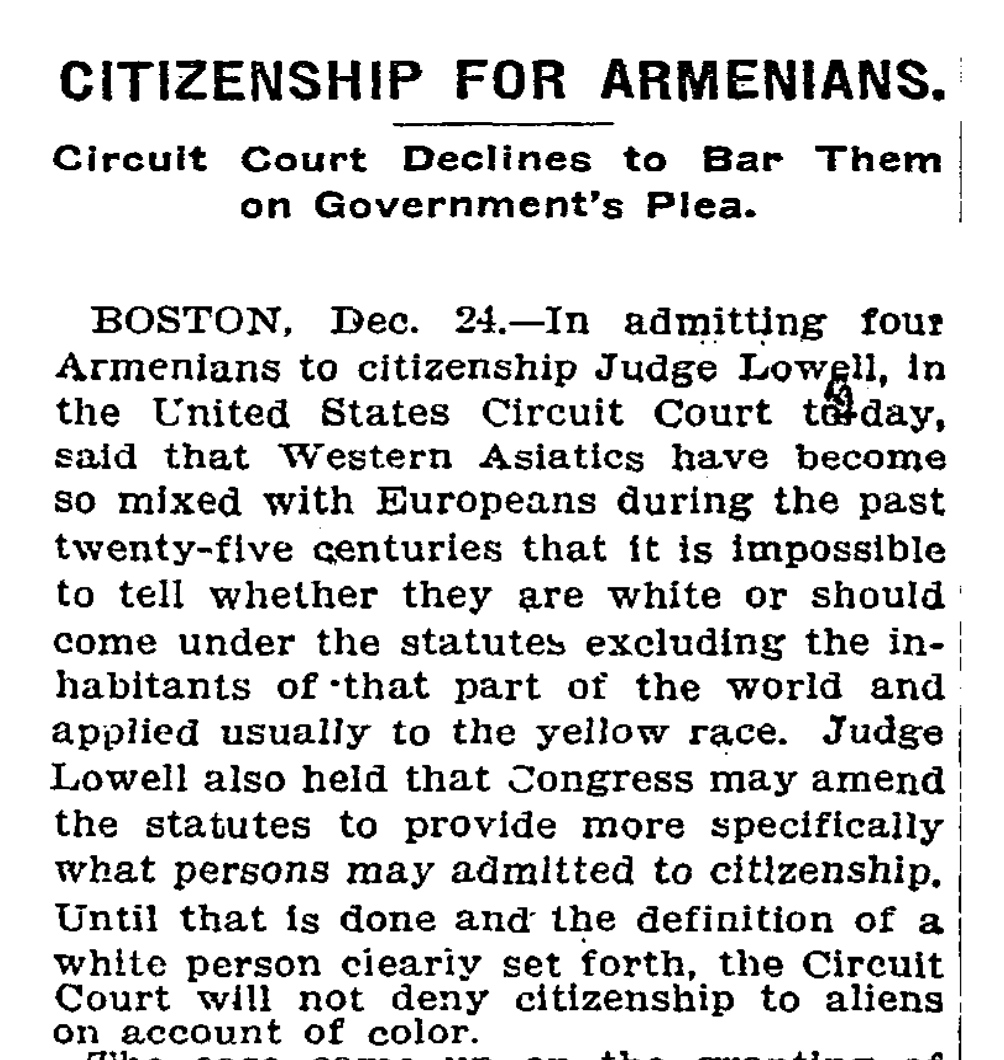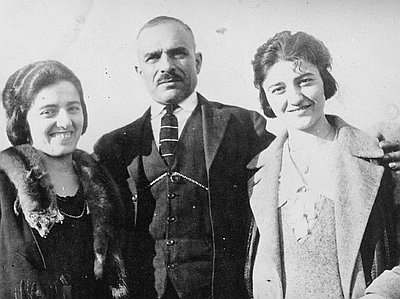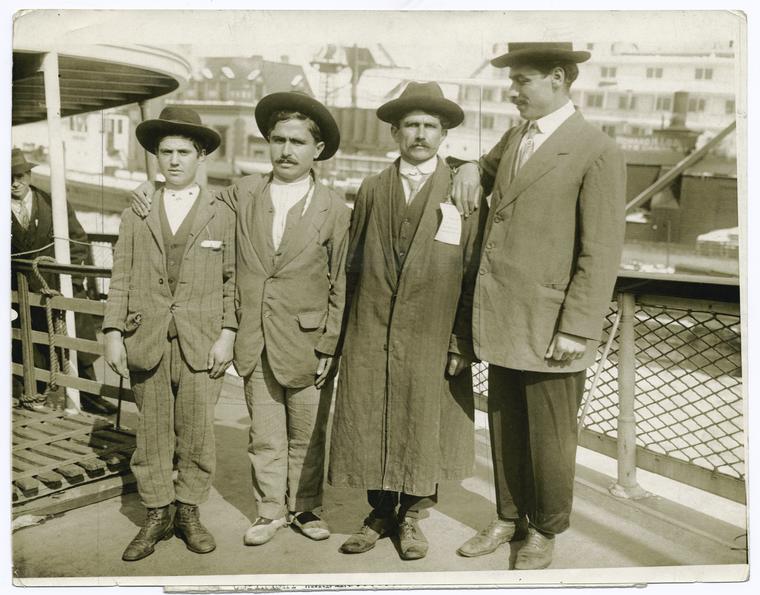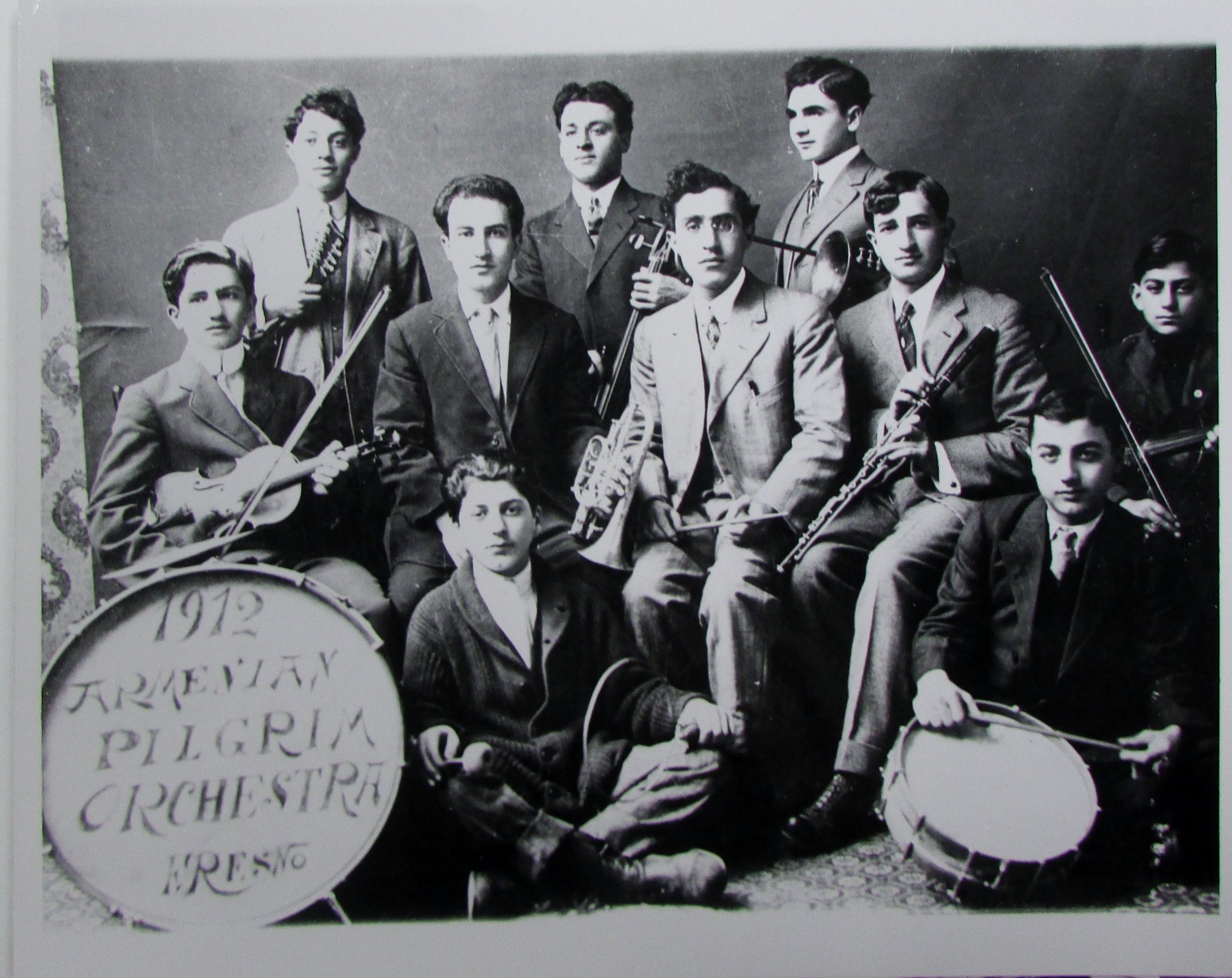The following is a guest post by Aram Ghoogasian, a teacher and writer from Los Angeles. His work has appeared in several publications, including The New York Times, Armenian Weekly, and The Daily Bruin.
The conversation initiated by this article continues in a follow up piece in the Los Angeles Review of Books with the author, where he further elaborates on the topic.
***
On Christmas Eve 1909, four Ottoman-born Armenian men received an auspicious gift from a circuit judge in Boston.
Jacob Halladjian, Mkrtich Ekmekjian, Avak Mouradian, and Basar Bayentz had petitioned for citizenship in the face of government opposition and won. A small headline wedged into the congested third page of The New York Times unceremoniously announced their legal triumph to the world the next morning: “Citizenship for Armenians.”

Though the brief article was likely of minimal import for most people who picked up a copy of The Times that Saturday, the historical consequences of the case proved momentous. Judge Francis C. Lowell hadn’t simply deemed four immigrants eligible for naturalization; he bestowed upon Armenians the juridical distinction of whiteness for the first time.
A few months later, Congress codified Lowell’s decision, decreeing that Armenians, along with Assyrians and Jews, were exceptions to the rule that so-called “Asiatics” were ineligible for naturalization.
Although whiteness would not receive a somewhat positive legal definition until 1924 – a Virginia anti-miscegenation law defined whites as those who have either “no trace whatsoever of any blood other than Caucasian” or “one-sixteenth or less of the blood of the American Indian and have no other non-Caucasic blood” – naturalization was restricted to white persons by the Naturalization Act of 1790. This provision stayed in place until the enactment of the Immigration and Nationality Act of 1952, though there were frequent changes to the requirements in between.
Because of the malleability and general instability of racial categories, Armenians were able to take advantage of the blurry boundaries of whiteness, going from potential members of the “yellow race” to white persons eligible for naturalization.
Despite the ruling in favor of the four Armenians, one of the arguments in the 1909 case laid bare that their classification as white was far from set in stone. Along with scientific racism, “popular knowledge” was often used as a justification for including or excluding people from the elusive racial category, especially in the early twentieth century. This hardly-definitive criterium was on full display in the Halladjian decision; the brief issued by the United States contended that “without being able to define a white person, the average man in the street understands distinctly what it means.” Furthermore, the proverbial average man would ostensibly “find no difficulty in assigning to the yellow race a Turk or Syrian with as much ease as he would bestow that designation on a Chinaman or a Korean.”
The judge dismissed this argument on the grounds that skin color alone was not a useful indicator of whiteness, adding that the four men – all of whom hailed from cities within the modern-day borders of the Republic of Turkey – would, in appearance, “pass undistinguished in western Europe.” The court even went so far as to reject the notion that certain racial categories existed in the first place, finding that “there is no European or white race, as the United States contends, and no Asiatic or yellow race which includes substantially all the peoples of Asia.” Nevertheless, the judge ruled that, if the “ordinary classification” was followed, Armenians had always “been reckoned as… white persons.”
Regardless of the decision, the fact that representatives of the United States relied on flimsy, racialist logic in a court of law carried some weight. Whether intentional or not, the state gave credence to the notion that something as unreliable as a typical person’s supposed perception of race was enough to potentially bar an entire group of people from the benefits of naturalization. The court’s finding that the racial categories upon which American naturalization law rested did not exist only worked to compound the uncertainty.
As such, Armenians’ legal status as white persons was not firmly secured by In re Halladjian. It would take a second court case, this time in Oregon, to put the matter to bed.
In 1923 Tatos Cartozian, a resident of the United States of nearly twenty years, applied for citizenship and received provisional approval after physically presenting himself to the court for “visual scrutiny” – in other words so the judge could ensure his skin was the proper tinge of white. Not long thereafter, the attorney general’s office filed a suit to revoke his newly-granted certificate of naturalization, alleging that the rug merchant was not a “free white person.” Cartozian was going to court.

The resulting case, United States v. Cartozian, lasted until the summer of 1925. District Judge Charles E. Wolverton, a Theodore Roosevelt appointee, was tasked with determining whether Cartozian qualified as a free white person as outlined in the eighteenth-century Naturalization Act. Like Lowell before him, Wolverton stated that skin color was not a practical litmus test for ascertaining citizenship eligibility, but resolved that “it may be confidently affirmed” that Armenians are white persons, basing his conclusion in part on the belief that they “readily amalgamate with the European and white races.”
Citing Herodotus and Strabo to bolster the claim that “Armenians are of the Alpine stock” along with expert witness and noted anthropologist Franz Boas’ assertion that “it would be utterly impossible to classify [Armenians] as not belonging to the white race,” Wolverton dismissed the bill of complaint. The state, just as it had sixteen years earlier in Massachusetts, found itself on the losing end; Armenians’ claim to whiteness had been reaffirmed.
The first quarter of the twentieth century saw Armenians go from “Asiatics,” at least in the eyes of the state, to legal white persons. Doubtless, the difference was palpable. Four years after Halladjian, California had passed its alien land law, which denied the right to own, lease, or “otherwise enjoy” land to people ineligible for citizenship, giving Armenians the edge on some of their fellow immigrants. Over time, this access to land ownership and housing loans allowed many Armenians to become relatively wealthy farmers in places like Fresno County, California.
Structural advantages notwithstanding, Armenians were still unable to assimilate completely. Fresno, a hub for Armenian immigrants in the 1890s and early 1900s, serves as a representative example here as well. While Armenians quickly established themselves as a sizeable minority in the city, many Fresnans considered them to be non-white and treated them accordingly. They faced exclusion from social activities and discrimination in landowning and employment, and were even excluded from a Protestant church they helped establish.
Armenians were also vilified for being stereotypically thievish and dishonest. Adults and children alike regularly faced racial invectives such as “dirty black Armenian,” “low-class Jew,” and – most commonly – “Fresno Indian.” American-born author William Saroyan, a Pulitzer Prize and Academy Award winner who was certainly no stranger to mainstream American culture, wrote in one of his many memoirs that “Armenians were considered inferior” and were “hated” in his hometown. In the same work, he recounts an episode from his childhood in which one of his schoolteachers told him it was rude to speak a foreign language in class, saying, “this is America, now.” The prolific writer apparently thought, even in his young age, that the teacher openly disliked Armenian children. To make matters worse, Fresnan Armenians had to deal with more institutional modes of discrimination as well, such as restrictive housing covenants in the city that lasted until the middle of the twentieth century.

While some of these conditions persist to the present day as part of a broader culture of nativism and xenophobia endemic to the United States, they now come in large part without demonstrable socioeconomic consequences. Today Armenian Americans, on the whole, enjoy high levels of wealth relative to many non-whites, an observable trend more attributable to Armenians’ racial position – which is but one of many inextricable demographic factors such as occupation, educational attainment, etc. – than their fabled proclivity for hard work. In 2015, per capita income in the United States was an estimated $29,979. For Armenians, that figure was $36,644, more than double that of people the Census Bureau recorded as “Hispanic or Latino (of any race),” about 80 percent more than that of “Blacks or African Americans,” and just slightly greater than the number reported for “Asians.” If these statistics are any indication, Armenians have achieved a degree of social mobility that has never been attainable for the Black and brown classes of America.
About four hundred years ago, an Armenian servant to the colonial governor of Virginia reached Jamestown, possibly the same year the first Africans – Kimbundu and Kikongo speakers from the Angola-Congo regions – in English America were transported to the same settlement by pirates in 1619 and sold into bondage. It would not be until the late 1800s, however, that Armenians began arriving to the United States in significant numbers, thus marking the beginning of their fraught relationship with the country’s particular racial regime.
Despite considerable improvements in the community’s material conditions over time, this relationship is no less complex now than it was during the legal drama of the last century. As whiteness itself is continually being defined and redefined by ever-shifting frontiers, so too is the racial position of the hundreds of thousands of Armenians living in contemporary America. Though the margins of whiteness remain a site of fierce contention, at least one thing is certain: the lines of demarcation are just as ambiguous today as they were on that December day in 1909.













35 comments
Proximity to whiteness is a racialized phenomena. I wish the writer went deeper with the working immigrant class of armenians in USA. Their racialization is significantly different from 2nd/3rd generations. The invisibility of this group is frustrating w the Diasporan hyphenated Armenians. They do not represent them and/or their voices.
I see very similar patterns with hyphenated identities, like 2nd and 3rd generation Iranians and Syrians relating to their proximity to whiteness. Again, class + race is a very crucial lens to analyze the racial regime in USA.
This article conflates and makes assumptions about a few things that I don’t like.
Firstly, we, Armenians, are not a ‘victim group’ as those others mentioned in this article. I don’t like the parallels, the light xenophobia that some Armenians experienced compared to the racism. Xenophobia was true for many, from Irish to Italian etc, but racism is specific.. Armenians, due to our cultural heritage, the church etc. have always been a privileged group. We had what others didn’t, an organizational capacity.
Secondly, Armenians have some, not large, but some racial diversity. It’s due to the size of historic Armenia, which spread from modern day Syria to Caucasus, modern day Armenia, unfortunately, is only the Caucasian highland part. So, you have Armenians ranging from those who look like Kim Kardashian to those who look like Ed Sheeran, which is the case with my family. Most of us living in Caucasus didn’t emigrate to U.S. but stayed here or went further to the north. Hence you, in the U.S. think that all Armenians look like “Kim K”, this couldn’t be further from the truth. Just statistically, today, most of us are as ‘white skinned’ as it gets. Which brings me to my final point.
The skin color and the American concept of ‘white’ are different things. In northern caucasus you have blond/red head muslims, but will these groups ever be considered white in the U.S.? No, of course. What the term white always meant is seems had to do with the culture, the religion, and the language. Armenians, which literally means arian men, are the oldest Indo-european language group. Moreover, we are the older christian nation/community, which also assumes a certain world view or a community.. This is what made it so easy for Armenians to assimilate.
I couldn’t care less how you classify Armenians in the U.S., it’s irrelevant. What I care is for us, Armenians, to be clear about our heritage and who we are. From the greater Armenia to the crusader state to the modern day Armenia, we are, and should see ourselves, as one of the bedrocks of the European civilization.
Sounds like you believe in some type of pseudo-science. Armeno is part of the Sanskrit- Aryan-Greco-Armeno Indo-European language. Actually, Iran means Aryan and there are people who say Iranians are the true Aryans (eye roll), mixing Indo-European linguistics with some kind of European eugenics science. Just awful. “Ian” means child of (a more gender neutral version of “son of”.
Sounds like you are not into the brown-skinned Armenians. We are indeed very diverse looking.
Also, please don’t speak on behalf of people who experience and continue to experience xenophobia and racism based on their ethnicity and group association (immigrant).
I know too many cases, including my own experience, of Armenians who have been told to go back to Armenia, featured in racist caricatures with exaggerated features, called fraud, and the list goes on.
“white” as in settler-colonial machine (and descendants thereof) does not include us as a group. We were under the ottoman colonization when white settlers and their descendants were committing crimes of genocide and slavery on this land. We did not accumulate the type of wealth that these traces of settlers did.
But yes, we benefit from being able to own property in 1920s, along w other minority groups (Syrians, Iranians, Mexicans, etc).
Also, it’s important to note that after the Civil War, the Naturalization Act of 1870 specifically excluded folk from the Asia continent but also did something really powerful because of Black emancipation — it extended the naturalization to people of African descent.
Our racialization is ongoing. It didn’t stop in Fresno. Nor has it stopped in Russia. None of it excludes the fact that we have proximity to whiteness. But what does that mean to a community that is full of poor and working class who are ashamed for their socio-economic situation and erased of their existence?
brown skinned Armenian,
Vera
I agree, Vera. I’m an olive-skinned Armenian with black curly hair, almond-shaped eyes, and I wide nonsensical. I’ve gotten a fair share of racist comments from white folks around the city I go to school in. “Sand nigger”, “Armenian shitskin”, “camel”, “terrorist”, etc. Many Armenians have dealt with this treatment before. I hate when fair-skinned (likely Caucuses) Armenians suggest that Armenians as a whole are accepted fine by whites and don’t deal with any racism. It’s a load of crap. There are plenty of olive and brown Armenians in the U.S. who are treated no differently than Arabs and Hispanics are. Many Armenians have Middle Eastern DNA, as that’s where most of Historic Armenia was situated. So, we’re seen as being no different from Arabs in most cases. Caucuses Armenians need to stop speaking for Middle Eastern Armenians, as they have no idea what kind of prejudice we face from white folks.
My sentence had a misspelling ‘we are one of the older Indo-European languages and the oldest Christian community’ and this is absolutely correct. Your extra classification doesn’t add anything, it’s tautology. Two very simple points. One, Armenian language is autonomous and, two, it is one of the oldest languages within the Into-European language group. Yes, farsi is also an Aryan language, but they are not Christian and they don’t have their own phonetic alphabet. There’s the big difference. The ‘whiteness’ is a composite of several things, that includes the Christian heritage and the underlying connection with the European culture.
All aside, you don’t seem to understand what’s the overarching argument here. If today, after this much collective evolution, you as an Armenian see yourself as a ‘victim’ then something’s wrong with your psyche. After the millennia of wars and ‘oppression’ we Armenians are alive and prosperous worldwide, it is clear that we are not a ‘victim’ type community. We too, have evolved, and occupied before the genocide, and I’m not just talking about the crusades. Read Lawrence of Arabia’s interview about the Armenians, and see for a moment how others saw us as a culture for centuries before the genocide.
I actually see it as a strength that both ‘brown’ and ‘pale’ Armenians are equally proud of their heritage and are one people. This is great, what’s the argument here? We are what we are, just don’t paint us all as looking like ‘Kim Kardashian’ that’s all.
You personally have been bullied because of your looks, boo whoo, grow up. That’s not racism.
Vera, I’ve been racially profiled at airports. I’ve been disrespected by police and accused of crimes I didn’t commit. I am talked to in far more demeaning ways by members of authority than that of the majority population. I certainly face obstacles that whites (Euro-Americans) do not have to deal with. Hell, even my white friends point it out to me all the time. Stop speaking for all Armenians. You’re just another whitewashed one.
Bryan Zazaian, this whole discussion is simply about you looking like an Arab, it has nothing to do with you being an “Armenian.” In fact you’re just a self-proclaimed one; you lack an actual legitimacy to call yourself an Armenian because you don’t reason like one, so don’t even try to go there. You most likely don’t speak the language, don’t contribute, aren’t a citizen etc.. at the end of the day, you act like the caricature of an Armenian portrayed by a Turkish ultranationalist, so don’t be surprised if Armenians don’t accept you.
Your post is spot on.
I’ve been racially profiled at airports. I’ve been disrespected by police and accused of crimes I didn’t commit. I certainly face obstacles that whites (Euro-Americans) do not have to deal with. Hell, even my white friends point it out to me all the time. Stop speaking for all Armenians. You’re just another whitewashed one.
You sound like a little cry baby. Even your profile pic makes me petty you, oppressed little thing. It must be real hard to cope with that kind of pressure. You’re not a victim like the Yemeni or the Rohingya, no, much worse, your a citizen of a developed western country who had to put up with a brutal institutional oppression. Unbelievable.
Varda, bullying and making fun of someone’s actual experience is extremely condescending. Go ahead, cuddle up with whiteness.
For myself and others, I hope white supremacy suffers a terrible death soon.
I am aware of those kind of incidents, but that doesn’t change the racial classification and history of Armenians in the West as a whole. Many Italians, Greeks, Albanians, Bosnians, Romanians, and Portuguese people have faced this problem because of their swarthy complexions.
As far as your insult of “whitewashed”, that label can only be applied to those that have faced institutional and systematic oppression from White America. Groups like Africans, Indigenous, and certain Mexicans. An Armenian can be Westernized culturally, or Russianized if he lives in Russia, but not “whitewashed”. An Armenian, no matter how swarthy or foreign his accent is, cannot be oppressed by Whiteness.
According to US census records, my wife’s Armenian grandmother and grandfather immigrated from Turkey in 1900 and were naturalized in 1906. The US government’s opposition to naturalization of Armenians must not have been a policy that was consistently followed by its immigration lawyers.
Actually, your ethnic origins and your race are completely independent of the Government. When they moved armenians (or other groups) from one category to another , they didn’t change their genetics. The only way you can know your ethnic origins is by a DNA testing. So, any kind of discussion on this topic is useless,because people stereotypically portray europeans as light skinned, light haired and with blue eyes, while europeans can and are of different colors, including of darker complectionlso (greeks, spanish, italian etc.).
Darling, you have to see the laughable inanity in both of your positions. You are absolutely privileged, have opportunities most of the world doesn’t and yet you’re so unaware of your own culture that you run with the local political trend of victimizing, excluding and marginalizing yourself, because you don’t fit in? We never fit in. Or are you so mentally confused that you can’t even distinguish between the historical cause of genocide recognition and your current regional identity politics? I’m amazed how you’re so willing to become little pawns in your provincial politics.
This is a response to Vera of course.
Sorry but Armenians are culturally, racially and ethnically non-white. They generally have a heavily middle eastern countenance. They are geographically located closer to non-white Iran and Iraq than they are Europe. Stop trying to be white and be proud of your BROWNNESS.
I know. While this article recognizes the proximity to whiteness + court cases that has made many “white” — including Mexicans and North Africans, it is majorly lacking in the actual reality of “otherness” and Armenian experience in USA, including a significant majority who are poor and working class. I am quite troubled by this erasure.
I don’t know how anyone with the username “Armenians are not White” can be taken seriously. In the USA, we are White. “Brown People” is not an appropriate term for Armenians. That term is strictly for South Asians, Indigenous people, and South East Asians. Just because we highlight the fact that we have enjoyed the same privileges as that of European people in the USA does not mean we claim to be European. Second of all, Levantines, of whom we share cultural and phenotypical similarities to, are also classified as White and have been historically.
While this article recognizes the proximity to whiteness + court cases that has made many “white” — including Mexicans and North Africans, it is majorly lacking in the actual reality of “otherness” and the Armenian experience in USA (especially those who are immigrants and first gen), including a significant majority who are poor and working class. I am quite troubled by this erasure.
I know the title qualifies it for “hyphenated” armenians (i.e. Armenian-Americans) in USA but please don’t universalize this experience. Speak to Armenian immigrants in Los Angeles or Fresno. Speak to Armenians in Turkey. Speak to Armenians in Russia. Speak to Armenians in Georgia. in Malta. in Germany.
I read this article with interest. I wrote about this exact topic in 2002, and I wish that the author had acknowledged my work. Here is a link to my article:
https://www.jstor.org/stable/3250644?seq=1#page_scan_tab_contents
If you can’t open it, please contact me and I’ll be happy to email you a copy.
I read your article and find it quite interesting. I would love to read more.
Hi Mary,
Glad you liked the article. I don’t think there’s anything else published on Armenians and whiteness, but there is a plethora of academic writing on whiteness in the U.S. You might check out David Roediger’s Wages of Whiteness; Richard Dyer’s White; Toni Morrison’s Playing in the Dark (this is literary); Ruth Frankenberg’s White Women, Race Matters; Karen Brodkin’s How Jews Became White Folks.
If you want something basic about white privilege, look at Peggy McIntosh’s “Unpacking the Invisible Backpack”.
Best,
Janice
Hi Janice. Is the offer still valid? I am no longer in academia and it is hard to get my hands on literature, unfortunately.
Hi Marie,
Yes, I’m happy to send the article. What is your email address?
Regards,
Janice Dzovinar
Hello Janice,
I would really appreciate a copy of your article.
I’ve received several requests on via this forum for copies of my article “Becoming White.” I am happy to send it to anyone who does not have JSTOR access.
Please email me at jokoomian@ric.edu if you’d like a copy.
I am an olive skinned Armenian born in New York City. I had a DNA test done 6 months ago. It turns out I am 88.6% classified Mesopotamian/Syriac/Southeastern Anatolian. My results said 0.9% European. I also had 3.6% Lebanese and 4.4% North African admixture.
It was a very strong geographical focus QAMishli Syria and Van turkey.
I grew up in northern New Jersey and all Irish and German town. The Anglo-Saxon kids constantly called me camel jockey.
I knew from a child that I was not wait and I was not like the other kids based on the way they treated me and spoke about me. There is no way that Armenians are white.
Varda is one crazy person above with her comments
it is funny how some armenian people can be seen as white people. i am armenian from turkey, living in europe. I have absolutely nothing to do with the country Armenia because i don’t believe it’s a part of the history that I know anyway , here in Europe as a Armenian you really are not seen as a European White. you would be seen as a Central asian- middle eastern or even North African for example me they think mostly I’m Indian-Pakistani or a Turkmenian or even mixed. I’ve seen some Armenians with blonde hair en blue eyes from Armenia but still they don’t fit in the Term white but more Persian & Afghan
Absolutely. What counts as “white” varies by country and also by time period.
This is a fascinating and informative post! I had no idea that Armenian-Americans were considered white in the US until relatively recently. The history of racial classification is fascinating and complex, and it’s important to recognize how these categories have shifted over time. As an Armenian-American myself, I find it interesting to see how my own identity has been shaped by these historical events. Thank you for sharing this important story!